 Understanding cholesterol numbers is important for keeping your heart healthy. Cholesterol is an integral part of heart health. If your numbers are off, it could be a sign of a future cardiovascular event.
Understanding cholesterol numbers is important for keeping your heart healthy. Cholesterol is an integral part of heart health. If your numbers are off, it could be a sign of a future cardiovascular event.
Cholesterol is integral to our overall health, but it’s important to maintain the right balance between LDL and HDL cholesterol in order to keep your heart healthy. LDL cholesterol is known as the bad type because it builds up along artery walls, making them narrow and preventing blood flow.
Advertisement
You may think that as long as you eliminate LDL cholesterol you are incredibly healthy. Unfortunately, this isn’t true. You still need a proper balance between the two types of cholesterol in order for your body to function properly.
How to measure cholesterol levels
Cholesterol is generally checked through blood testing. A cholesterol blood test will reveal your HDL and LDL levels, your total cholesterol, and triglycerides, which is another form of fat in the blood that can contribute to cardiovascular events.
Typically, your doctor will ask you to fast for nine to 12 hours prior to your cholesterol blood test – although some studies have shown this may not to be necessary. Your doctor will instruct you on any prep you need to undergo prior to being tested.
Understanding cholesterol numbers in adults
The below chart specifies the normal cholesterol levels for children and adults.
| HDL cholesterol levels | LDL cholesterol levels | Triglycerides | Total cholesterol | |
|---|---|---|---|---|
Children |
|
|
|
|
Adults |
|
|
|
|
Reducing cholesterol levels
What can you do to ensure your blood work looks great for your next physical? These four key ways can help you cut your “bad” LDL cholesterol, up your “good” HDL cholesterol, and improve your overall health:
Get your blood checked: As the Centers for Disease Control and Prevention (CDC) reminds us, high cholesterol can be symptomless – there’s no way to tell how yours measures up. That’s why getting regular blood tests as part of your physicals is important. The test, a lipoprotein profile, measures several kinds of cholesterol and triglycerides. The National Cholesterol Education Program recommends getting your cholesterol checked every five years, unless your doctor advises otherwise.
Get your exercise: Regular physical activity can help you maintain a healthy weight, which is a key part of keeping cholesterol levels in the healthy range. The Surgeon General recommends that healthy adults get two-and-a-half-hours of moderate-intensity exercise every week. Start with a short walk in your neighborhood or around the indoor shopping mall. Before you know it, you’ll look forward to the activity and make it a daily habit.
Advertisement
Eat better: Cutting the cholesterol in your diet is a good way to cut the bad cholesterol in your blood. Avoiding saturated fats (red meat, poultry, full-fat dairy products) and trans fats (look for them in processed foods, crackers, and baked goods) is key, as well as reducing your intake of dietary cholesterol.
Fats like monounsaturated fats and polyunsaturated fats (nuts, fish, avocados, vegetable oils, for example) can lower your dangerous blood cholesterol levels because they contain healthy fats. Eating fiber can also cut your cholesterol levels. The Heart and Stroke Foundation of Canada recommends eating 21 to 38 grams of fiber each day.
Stop smoking: Here’s one more reason to toss out those cigarettes for good. Smoking makes the potentially dangerous effects of cholesterol even worse. Smoking can speed up atherosclerosis or artery hardening, the CDC warns, and significantly increases your risk of heart disease and stroke. Add high cholesterol into the mix, and you’ve got a potentially deadly combination. Fortunately, quitting smoking will lower that risk. Talk to your doctor if you’re having trouble giving up the habit.
